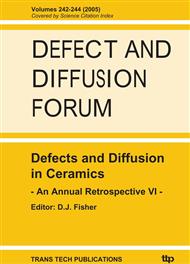p.1
p.9
p.17
p.27
p.43
p.65
p.77
p.95
p.107
Identification of Mg Vacancy in MgO by Positron Lifetime Measurements and First-Principles Calculations
Abstract:
The formation of Mg vacancy induced by ultra-dilute trivalent impurities in MgO is investigated by a combination of positron lifetime measurements and first-principles calculations. The undoped MgO yields the shortest positron lifetime of 140 ps that is shorter than that of a single crystal sample. The positron lifetime of the doped samples increases with the increase of the Al dopant concentration and is saturated at around 180 ps. This result clearly indicates that the formation of Mg vacancy is induced by Al dopant. The concentration of the other trivalent impurities can be evaluated using the result of component analysis of positron lifetimes. The experimental bulk lifetime of 130 ps, which is obtained by employing trapping model, is well reproduced by the theoretical calculation using the semiconductor model. The calculated defect lifetime is about 20 ps longer than the experimental value. This may be due to the lattice relaxation around Mg vacancy associated with the trapping of positrons.
Info:
Periodical:
Pages:
1-8
Citation:
Online since:
September 2005
Authors:
Keywords:
Price:
Сopyright:
© 2005 Trans Tech Publications Ltd. All Rights Reserved
Share:
Citation:


